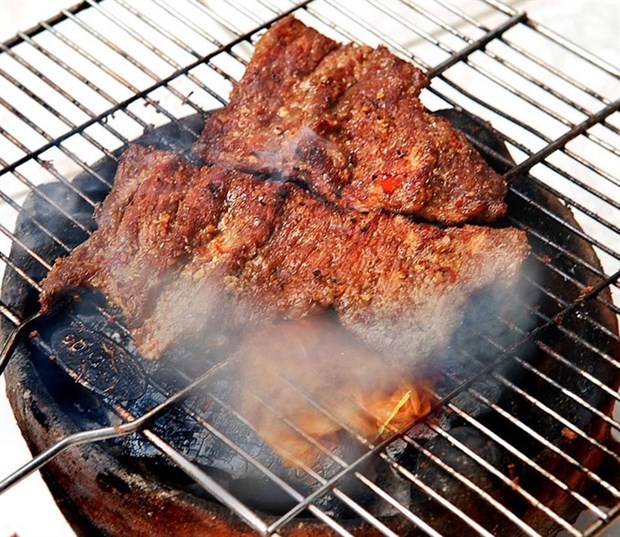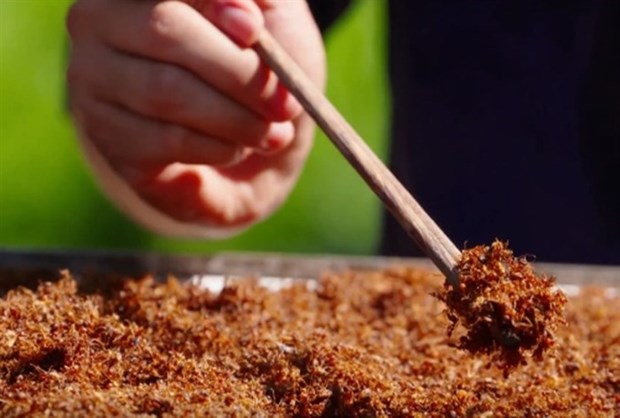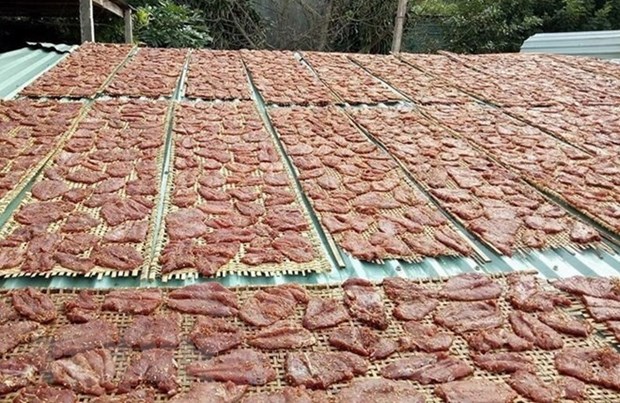In Vietnamese cuisine, there are many creative ways of preserving food, including fermenting, using salt and smoking.
But there is one method which is not only helpful in preservation but can create a natural flavour for the food, and that is drying it under the sun.
Specialties
preserved by this method are familiar, but to create an excellent and unique
specialty, is another story. This week’s story is about bò một nắng (beef dried in the sun) – a signature specialty from
the Tây Nguyên (Central Highlands).

Traditional dish: Bò một nắng grilled over wooden charcoal. — Photos Hồng Điệp
Last
month, we went on a volunteer trip to the Highlands. Our destination was Krông
Pa – known as the ‘fire pan’ of Gia Lai Province due to its extraordinary heat.
One
of the poorest districts of Gia Lai, and with temperatures of up to 41 degrees,
drought is a very serious issue. There isn’t enough water for living, basic
farming and especially feeding cattle – the main activity of residents.
Stopping
in Đất Bằng Commune – which has suffered most from the drought, we helped
authorities build a clean water tank and hold classes to teach people about
saving and using water.
To
express their gratitude, residents invited us to stay for lunch in a
traditional communal house, to try traditional specialties and talk with the
locals.

Dig in: Bò một nắng with yellow salted ants is much more enjoyable.
Surrounding
us were diverse kinds of delicious specialties such as Bản Đôn grilled chicken,
venison, grilled wild boar and Gia Lai dried phở. But one dish that impressed
me was the bò một nắng.
Although
it was just beef, I had never tried that kind of beef before. It was grilled on
the outside, but the inside was still pink.
It
was perfect to accompany a drink as the beef’s flavour is a delicate
combination of the dried spice on the outside and the soft, greasy fragrant
layers underneath.
“Wow!
It has a very unique and natural taste. I’m very impressed as I used to think
that there can’t be any new way to cook beef. But it turns out creativity is
like a moving bicycle wheel – to always move forward, we have to cycle and
brainstorm new ideas, and the idea of making this kind of beef is brilliant,”
said Nguyễn Mỹ Linh, another member of the volunteer group.
Ngô
Minh Hòa told us an inspirational story not only about the origin of this food,
but also about the way locals overcome the harsh weather.
“The
reason we call it ‘một nắng’ is
because it is already ‘roasted’ once before the second roasting. We take
advantage of the heat and our cattle in Gia Lai to expand the scale of
producing this specialty. After the early cooking process, we dry the beef under
the strong sunlight. With the typical heat of Krông Pa, it takes 30 minutes for
the beef to completely dry out. This stage eliminates bacteria and gives the
beef a really natural aroma,” said Hòa.
“We
used to get depressed when thinking of how much damage this terrible sunlight
had done to us. We watched our Ba River evaporate from a majestic current to a
small stream. But instead of sitting there and waiting for a miracle, we stood
up for ourselves and turned the disadvantage into an advantage,” he added.

In the heat: Drying meat under the sun makes it more delicious.
What
surprised us more was the spice used with the beef. It was brown, a little bit
sour, spicy and salty. But above all, it tasted very delicious, natural and
paired well with the half-dried beef.
Hòa’s
answer stunned us once again. The spice isn’t made from sea water like other
kinds of salt. It comes from an unwanted creature – ants.
They
are yellow ants, one of the specialties of the region. They live in trees in
the forest or fruit trees of Krông Pa and contain a lot of nutrients.
After
lunch, with some pieces of bò một nắng
and yellow ants to take home, Hòa showed us the process as his store.
“In
order to maintain the signature flavour of this “fire pan” area, the flesh has
to be taken from the thighs of the bulls, cut into small pieces of one
centimetre, then marinated with mixed spices of salt, chili powder, garlic,
lemongrass and sesame. The beef has to be perfectly marinated. If it’s too
salty, it will lose its original flavour; but if it’s too bland, it will rot,”
said Trần Thị Thiên, one of the most experienced cooks.
“About
the yellow ants, you wouldn’t imagine how hard it is to catch them. To prevent
ourselves from getting stung we have to dress from head to toe. We carefully
chop the ant’s nest and put it into the prepared net. After that, it is roasted
to get rid of the leaves, dust and other impurities,” Thiên added
In
Krông Pa, locals have other ways of making the yellow salted ants, such as
adding cinnamon leaves.
With
prices ranging from VNĐ450,000 to VNĐ500,000 per kilo of bò một nắng and VNĐ20,000 for one box of yellow salted ants, it is
really worth a try.
Now,
every time we have a drink, I always bring this special snack with me, share it
with others and talk about the trip to Krông Pa – the home of this amazing gift
from the wild and majestic Central Highlands.
By VNS